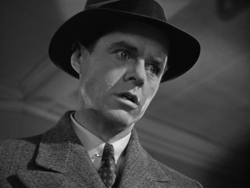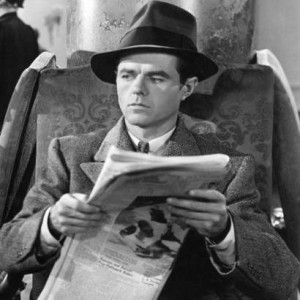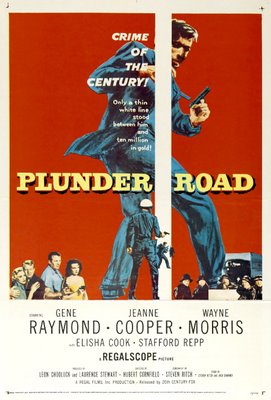
First up is perhaps noir’s most valuable supporting player, Elisha Cook, Jr. At five foot five, with bug eyes and a raspy whisper of a voice, he was dubbed “Hollywood’s lightest heavy” a title bestowed on him because he shot to fame playing the diminutive goon Wilmer in John Huston’s 1941 genre defining The Maltese Falcon. In a film full of great performances, his teary-eyed psychopath stands out without seeming to do much but mutter threats under his breath. Although he spends the whole movie getting slapped around by Bogart, there’s a slow boiling rage in those big, wet eyes.
That same year he played another psycho in another early noir, I Wake Up Screaming. While it’s not the masterpiece that Falcon is, and while its noir identity is not fully formed (with goofy asides and a romance thrown in) I Wake Up Screaming still helped lay the groundwork both visually and thematically for much of what would follow it in the forties and fifties. Cook overplays his part (at the behest of the director, once can sense), but here he is, for the second time in 1941 putting a vision of violent psychosis on-screen.
Cook had actually arrived to the noir party a year earlier with a little 63-minute Expressionistic gem called Stranger On The Third Floor. Here you can really see the genre taking shape. Cook plays a nervous little cabbie wrongfully accused of murder. His part is small but showy, and in keeping with the style of the film, which owes much to silent German cinema, Cook doesn’t just decry his persecution, he explodes all over the screen, those big eyes of his filling up like water balloons. He’s not subtle, but nothing about the film is subtle. It’s a highly stylized nightmare, and Cook fits right in.
As the years went on, he continued issuing fine performances in a whole slew of noirs. He’s the horny little drummer who drags Ella Raines into an orgy-like jazz session in Robert Siodmak’s gorgeous 1944 Phantom Lady. He rode shotgun with brawler Lawrence Tierney in 1945’s so-so Dillinger and teamed up with him again in the far superior 1947 Born to Kill. He and Tierney were real-life fishing buddies, but in their movies, Cook had a habit of getting killed.
 In 1946, he had one of his best roles, opposite Bogart again, in Howard Hawks’s The Big Sleep. Cook plays a “funny little guy” named Harry Jones. In love with a no good woman, Cook wades into an underworld of killers, an underworld from which he will not return, but he’s got integrity and no small degree of guts. His big scene with tough guy Bob Steele—wherein the dead-eye killer makes him drink poison—is one of the best scenes Cook ever played.
In 1946, he had one of his best roles, opposite Bogart again, in Howard Hawks’s The Big Sleep. Cook plays a “funny little guy” named Harry Jones. In love with a no good woman, Cook wades into an underworld of killers, an underworld from which he will not return, but he’s got integrity and no small degree of guts. His big scene with tough guy Bob Steele—wherein the dead-eye killer makes him drink poison—is one of the best scenes Cook ever played.
Somehow, none of his fine work ever translated into stardom. He kept on, though, just another working stiff punching in for the night shift at the Dream Factory. He worked on no-budget pictures like Monogram’s 1947 Fall Guy and the King Brothers’ The Gangster the same year. He worked opposite Henry Fonda in The Long Night, Alan Ladd in The Great Gatsby, and Marilyn Monroe in Don’t Bother to Knock. He was in the first Mike Hammer picture, 1953’s I, the Jury, and gets killed again—this time while wearing a Santa Claus suit. All part of the job.
That same year he was in the Western Shane, getting gunned down again (of course), this time by a ferocious Jack Palance. The picture was a blockbuster success, and Cook’s scene with Palance made Palance’s career. But it had no impact on Cook’s career. He was still dependable ol’ Elisha Cook. So what if he got blown away in the biggest hit of the year? He’d been blown away in half the pictures he ever made. That same year he started doing television. Why not? Might as well get gunned down on the small screen, too.
Two career highlights lay in store for him, though, and both were in the genre with which he had by this time become synonymous. In 1956 he got the best part of his life in Stanley Kubrick’s The Killing. One the great heist films, The Killing also features perhaps noir’s most dysfunctional marriage, the unholy union between a pathetic racetrack clerk (Cook) and his wicked wife (Marie Windsor). Cook and Windsor do a duet here that is a note perfect vision of marital hell. The archetypal little man of noir, Cook at last finds a role that makes him a truly tragic figure, while Windsor is a nightmare wife, sexy and horrible all at once. Watching these two together is the chief delight of the film. Windsor’s eyes are as big as Cook’s, but hers are filled with a mocking laughter. His pain and her scorn make for striking noir music.

With the close of the classic noir cycle, the steady supply of crime flicks slowed down. Still, Cook never stopped working. Television never gave him a starring role, of course, but it supplied plenty of opportunities to do his thing. He worked on all the big shows: Wagon Train, Rawhide, Gunsmoke, Perry Mason, The Untouchables, Peter Gunn, Bat Masterson, The Fugitive, The Man From U.N.C.L.E, even Star Trek and Batman. And more, lots more. By the end of his life most people probably knew him best for his recurring role as Ice-Pick Hofstetler on Magnum, P.I.
Not much had ever been known about Cook. Born in San Francisco in 1903 to a vaudevillian father and actress mother, he made his stage debut at thirteen and was making movies before he turned thirty. Despite being widely respected in the industry, he lived a reclusive life, preferring to stay up in the mountains and fish between movie roles. After a failed first marriage to actress Mary Lou Dunckley, he married Peggy McKenna in 1943 and stayed married to her the rest of his life. They had no children. He died in a nursing home in Big Pine, California, in 1995. If the world didn’t regard his passing as the loss of a giant of cinema, it’s a shame. He made every movie a little better. And he made great movies even greater.
Jake Hinkson, The Night Editor, is the author of Hell on Church Street.

Was there ever anyone better, or anyone more welcome on screen. As soon as he shows up in a picture, I breathe easier.
It’s so true. You know, I was thinking today…practically everyone I know who loves noir [b]loves [/b]Cookie. This guy just [b]was[/b] the face of film noir in a lot of ways.
Elisha Cook Jr. was the final ingredient that makes the recipe. The living proof that a terrific movie is akin to a Championship winning team. You must have a big star or two to be sure, but the supporting players(actors) often make the difference.